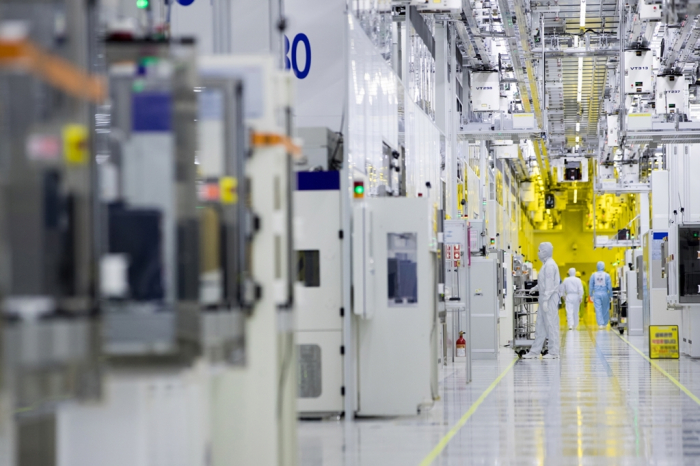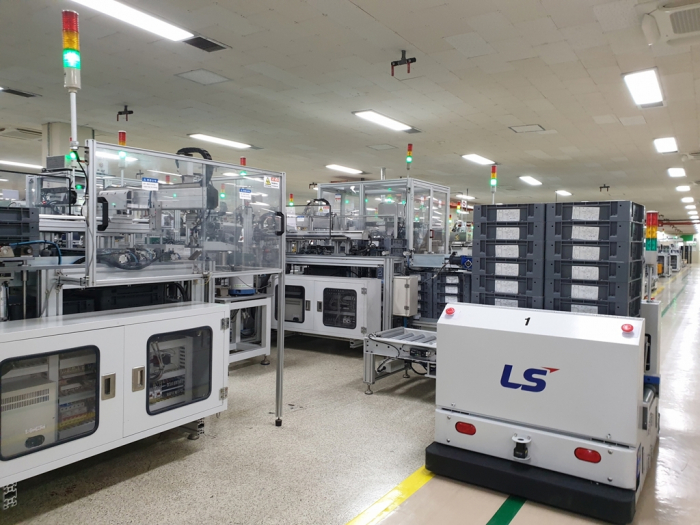Robotics
Samsung Elec. plans unmanned factories on manpower shortage
Other major South Korean manufacturers sure to follow suit, raising demand for industrial robots
By Aug 01, 2022 (Gmt+09:00)
4
Min read
Most Read
LG Chem to sell water filter business to Glenwood PE for $692 million


Kyobo Life poised to buy Japan’s SBI Group-owned savings bank


KT&G eyes overseas M&A after rejecting activist fund's offer


StockX in merger talks with Naver’s online reseller Kream


Mirae Asset to be named Korea Post’s core real estate fund operator



Samsung Electronics Co., the world’s top memory chipmaker, is seeking unmanned factories in a move that other major South Korean manufacturers are sure to follow as the falling population is set to cause a manpower shortage.
Samsung recently formed a task force to make key plants unmanned factories by as soon as 2030 with systems allowing all production processes to be operated with automated machines, according to industry sources on Monday.
“We expect available manpower to significantly shrink in the next 10 years,” said a Samsung official. “It is impossible to solve the manpower shortage issue given the declining population.”
South Korea’s total population in 2021 fell for the first time since the country began collecting such data, hit by a sharp drop in birth rates and immigration since the onset of the COVID-19 pandemic.
The population in Asia’s fourth-largest economy fell 0.2% to 51.7 million as of November 1, 2021, with the working-age population down 0.9%. Those aged between 15 and 64 are projected to account for 59.7% of the total population in 2037, down from 71.6% last year.
That is likely to cause major local companies to scramble for manpower, ramping up labor expenses and cost-related risks, industry sources said.
TO CUT PRODUCTION STAFF, BUT INCREASE R&D MANPOWER
Samsung was known to plan gradual cuts in production staff while increasing manpower for research and development, according to the sources.
“We need to reduce reliance on production personnel eventually for cost-effectiveness,” another Samsung official. “We plan to operate plants only with machines or robots.”
The company aims to minimize hiring production staff but increase manpower for the semiconductor business such as memory and system chips, as well as artificial intelligence and software. AI and software manpower are seen to be good for its businesses overall.
Samsung has been reducing its number of global staff annually since 2018. Last year, it had 266,673 employees worldwide, down from 267,937 in 2020, 287,439 in 2019 and 309,630 in 2018. The tech giant reportedly cut production personnel in Southeast and Southwest Asia, Japan and China in the last five years.
The company had significantly raised its workforce in other countries such as China and Vietnam before as it expanded overseas production of semiconductors, home appliances and mobile products.
OTHER MANUFACTURERS TO JOIN THE MOVE
Samsung’s plan indicates that manpower is not a key competitive factor in the manufacturing sector, industry sources said.
“It is not difficult to convert the existing plants to unmanned factories if we use various automation solutions,” said one of the sources. “But no one has dared take the measure, considering opposition from the existing production staff.”
Until the early 2000s, South Korean manufacturers focused on making more with more production manpower.
But they changed this strategy since global major companies such as Apple Inc. made large profits with fewer employees. The development of robot technologies, as well as the integration of sensors and machine learning, has also allowed for smart factories.
In the 2010s, major local companies such as Hyundai Motor Co. and LG Electronics Inc. expanded the construction of smart factories while automating production facilities and managing them with related systems.
LS Electric Co., a South Korean smart energy company, currently needs 1.5 employees for a production line at its local plant, for example, a sharp drop from the 15 staff needed a decade ago.

“In the early days of smart factories, there were concerns over trust in machines, but the new technology has reduced defect rates while improving productivity,” said an industry source. “Even with the current technology, there are not many technical risks for converting into unmanned factories.”
Some worry such moves will reduce overall jobs in the economy, but the concerns are likely to disappear given the falling population, industry sources said.
RISING INDUSTRIAL ROBOT SECTOR
The global industrial robot market is expected to more than double to $28.9 billion by 2026 from $14.1 billion last year, according to research firm MarketsandMarkets.
Industrial robots are steadily evolving from simple repetitive robots into high-speed robots with more advanced automation functions, such as assembly robots, intelligent cooperative robots and unmanned robots. Demand for robots with artificial intelligence is expected to increase in the future.
But an unmanned factory will not necessarily be operated without any workforce since it will need minimum staff for management, industry sources said.
“Most of the production processes such as polishing, piping and welding will be done by robots or machines instead of humans,” said Kim Young Min, a researcher at the Korea Institute for Industrial Economics & Trade. “The role of existing production personnel will be changed into that of productivity and efficiency management.”
Write to Ji-Eun Jeong at jeong@hankyung.com
Jongwoo Cheon edited this article.
More to Read
-
 BatteriesLG Energy, SK On to raise yields with smart factory solutions
BatteriesLG Energy, SK On to raise yields with smart factory solutionsMay 25, 2022 (Gmt+09:00)
2 Min read -
 BatteriesLG Energy begins joint research on smart factory tech with elite institute
BatteriesLG Energy begins joint research on smart factory tech with elite instituteMay 12, 2022 (Gmt+09:00)
1 Min read -
 ElectronicsLG Electronics turns home appliance plant into smart factory
ElectronicsLG Electronics turns home appliance plant into smart factorySep 16, 2021 (Gmt+09:00)
2 Min read -
 Electric vehiclesRobots, AI replace human workers at Kia’s EV6 manufacturing factory
Electric vehiclesRobots, AI replace human workers at Kia’s EV6 manufacturing factoryNov 22, 2021 (Gmt+09:00)
1 Min read -
 Electric vehiclesHyundai innovates EV manufacturing with smart factory system
Electric vehiclesHyundai innovates EV manufacturing with smart factory systemJul 02, 2021 (Gmt+09:00)
1 Min read
Comment 0
LOG IN


